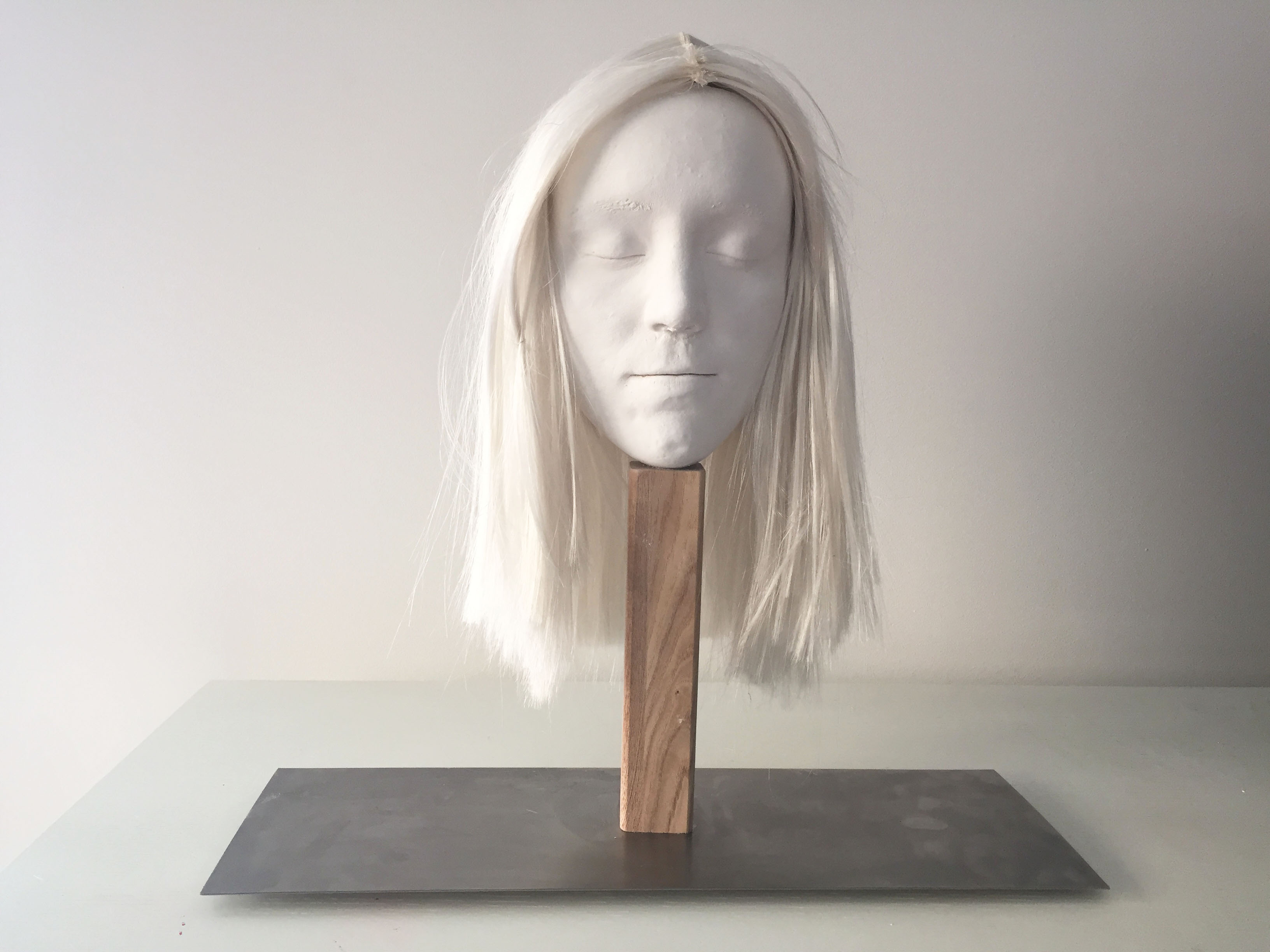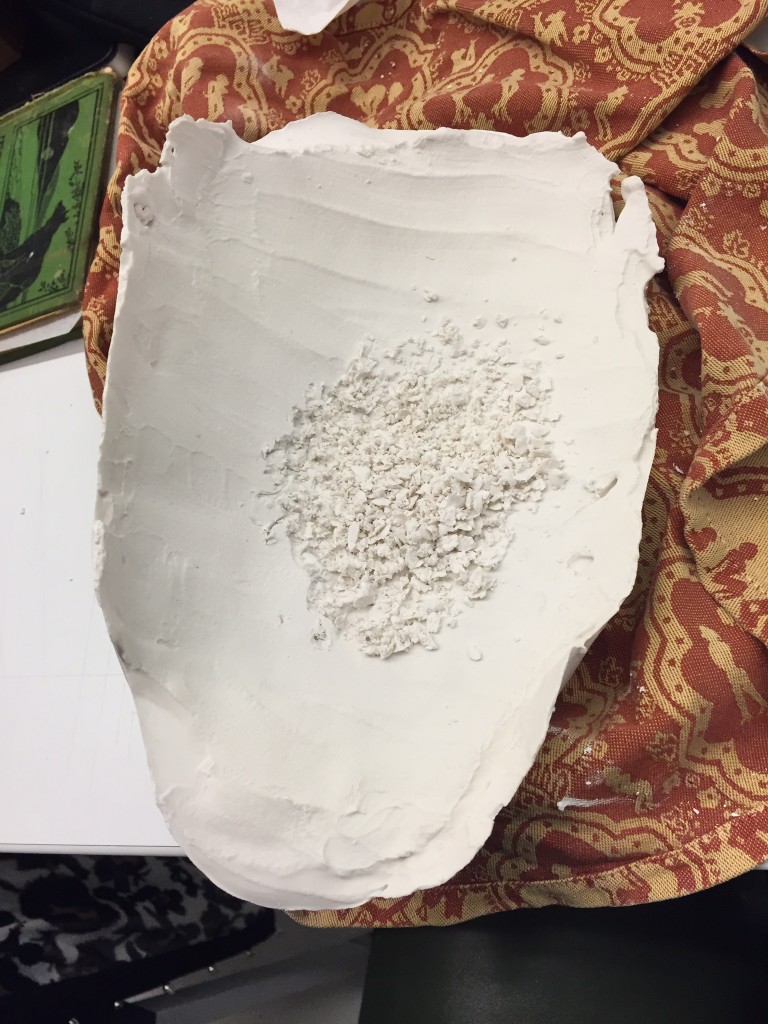For my Inside-Out Self-Portrait project, I decided to focus on my identity through a lense of emotion, which forms a big part of my personality. Realistically, I am planning to represent my face/head as a sculpture made off plaster, the face and the hair being white, as I think white is a color that represents my appearance really well. White is often associated with a sense of tranquility, softness and innocence, which are all qualities I see in myself when around people. By adding colorful, vibrant and geometrical patterns inside of my head, I try to abstract my personality and give the viewer an insight into my brain. This abstraction will change my “real” self, as I aim to show my crazy, and vibrant thoughts and emotions in contrast to my rather plain and quiet appearance.
To achieve this, I plan on building a plaster cast mask of my face using alginate, plaster bandages and plaster. I then plan to build a wire construction of the shape of my head and cover it with a white wig. In the back of the wig, there will be a small whole that allows the viewer to look into my head, where I will paint an abstract geometric pattern.
I’ve always been very interested and inspired by Geometric Abstraction and artist such as Mondrian, Richard Anuskiewicz and Frank Stella. Growing up in a family of engineers, maths has always been a big part of my life and I would definitely consider it as one of my strengths. Because of this, my work usually tends to be very planned out, measured and exact, as those are features I have been exposed to all my childhood. Especially when trying to convey a sense for the way I think, I think the mathematical aspect is very important, as I tend to think in numbers.
I started off by making the plaster face mask of my face. First of all I put vaseline on my eyebrows as well as hairline to make sure the alginate later comes off without problems. I then mixed the alginate with one part water, one part alginate and had a friend spread it on my face. After letting that dry for 5 minutes, she covered the alginate with plaster bandages. As that was starting to dry, it started to feel extremely weird, as I couldn’t feel where she was touching my face anymore, I could just hear her touching the plaster mask. After that dried for 15 minutes, I took off the mask and put it upside down into a paper box. Unfortunately, I didn’t use a shower cap, and had alginate as well as plaster all over my hear, which was a real struggle to get out. Finally, I mixed one part of water with two parts of plaster cast and then poured the mixture into the alginate-plaster form. I took out the mask after around 15-20 minutes, when the plaster had cooled down.
I was really surprised by the accuracy of the mask, however, the nose did not turn out as well as I hoped and neither did the eyebrows. For the nose, the problem were the little holes I left to breathe, as plaster got through them when I poured it into the form. I also think I used too much vaseline on my eyebrows, which is why they barely showed on the face mask.
- Plaster powder, alginate powder, plaster bandages, spatula, two mixing containers
- Spread alginate on face (left), dry for 5 min, cover with wet plaster bandages, dry for 15 minutes, take off two masks separately
- Pour plaster into alginate and cast form, let dry for 15-20 minutes and take it out of the shell
Something I should have thought about while pouring the plaster into the form was the weight of the mask, as I filled the whole form instead of just a thin layer. This could have been overcome by pressing a shape into the semi dried plaster, pushing all the spare plaster out of the mask. Since I didn’t do that, I had to scrape 80% of the plaster out again, which took much longer than I expected. I first did this using a screwdriver, which was very inefficient, and then moved on to a drill. Though the drill was much faster, I also accidentally drilled through the mask a couple of times, which I then had to fix by trying to fill in the little holes.
________
Final Outcome & Reflection
For the Inside-Out Project, I decided to represent myself by constructing a sculpture of my head. I created a plaster face mask of my face using alginate and plaster to create a form, which I then poured plaster into. On the back of this mask, I mounted a wire construction in order to create the round shape of the head. I then cut apart a white wig and sewed the separate strands of hair to the wire construction, leaving a little whole in the back. In order to make the sculpture stand up, I attached a wooden pole to the chin and a steel board to the pole, and fixed both with screw nuts. The face is painted with white acrylics to enhance the white color of the plaster. In the back of the head, there is a small hole where one can look into the head and see an acrylic painting of abstract geometric patterns. These patterns are alternating squares and diamonds, which get smaller towards the center of the piece. The colors subtly transform from yellow on the outside, to red and finally to blue, creating a rainbow like effect.
The reason I decided to represent and abstract myself like this is, that I tried conveying the contrast I feel that exists between my inside and my outside. I would say I am often perceived as a rather quiet and self-conscious person, who does not like to stand out. In a way, this is also part of my inside, as I do feel like I would rather not be in the center of attention, which often stops me from expressing myself and my thoughts. I consider myself a perfectionist who never reaches the goal and is never satisfied, not to mention proud of my work, but also my thoughts, opinion and ideas. This has lead me to develop an anxiety of failure, making me shut up rather than risking failure.
However, the inside of my inside, when you take away the anxiety and self-consciousness, is the complete opposite of my appearance. Inside of my head, I have millions of crazy thoughts and ideas flying around, like splashes of color that are thrown through the room.
I decided to work with color to effectively convey this contrast. For the outside, I chose white, as it is often associated with a sense of tranquility, softness and innocence, which are all qualities I see in myself when around people. It is furthermore a color that our eyes are very used to, meaning it will not catch as much attention and will create a rather calm image to look at. The inside, on the other hand, is based on all three primary colors, with different hues of those colors blending from yellow, to red and finally to blue. Since everything else is white, this use of vibrant and diverse colors really stands out and I think effectively displays the opposition of my in- and outside.
For the form and shape, I aimed to really make the form of my head as authentic, and therefore representational as possible. Using alginate really helped me achieve this, as even little details such as pores can be seen in the cast of my face. This representation creates a second contrast between the in- and exterior: the original form of my face against the very abstract geometric patterns and shapes.
Working with geometric shapes was my first instinct when thinking about how I could abstract my personality, not only because it is something that I personally enjoy looking at and have done in my work for a while, but also because I feel strongly connected to the mathematical and measured aspect of geometry. Growing up in a family of engineers, mathematics have always played a very important part in my daily life. While all of my siblings and cousins followed the for our family typical path of studying engineering, I constantly felt the need to create, causing me to try to combine design and maths. In this process, I looked at Geometric Abstraction and Op Art, focusing on artists such as Josef Albers, Piet Mondrian and Richard Anuskiewicz. Mondrian once said that “the emotion of beauty is always obscured by the appearance of the object. Therefore the object must be eliminated from the picture.” This quote has ever since I first read it inspired me and built my personal artistic style, as I consider color as the most important mean of expressing emotion through visuals.
Through the use of color and the use of shape, I furthermore tried to create a sense of depth and therefore three dimensionality to the painting to represent the infinite depth of the pool of thoughts and ideas inside my head. This is achieved by the use of alternating shapes, that get smaller toward the center of the piece, as well as the use of lighter colors for the outer shapes, that slowly get darker while moving to the center of the painting.
The wooden pole and the metal base were also intentionally chosen, as I think they really complement the simple and plain look of the sculpture, since both of the materials are natural and something we are regularly exposed to. I decided not to make the stand white, even though that was my first thought since I wanted to keep everything as plain as possible, because I wanted to create a clear differentiation between the head itself and the stand. Although the stand very much is a part of the artwork, it is not a piece of the representation of my head, which is why I decided to defer it in color from the head.













